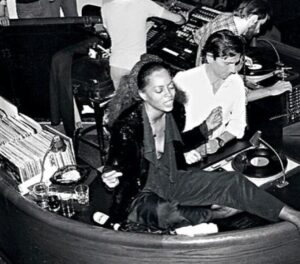The Art of the DJ: Turntables as Cultural Icons
Long before the word ‘DJ’ conjured images of stadium-sized light shows and pyrotechnics, it meant something more sacred. In the heart of disco culture, the DJ was not an entertainer. The DJ was a guide, a priest, a protector of the night. Behind two turntables and a crate of vinyl, they orchestrated emotion, connection, and liberation. And for many, the sound they sculpted from those spinning discs was a spiritual experience.
In the early days, disco DJs weren’t just playing records. They were crafting entire journeys. With seamless transitions, careful track selection, and a deep understanding of rhythm and mood, they manipulated time and space. The club became a cocoon, and the DJ held the thread. The dancers didn’t just hear the beat – they trusted it. They followed the build, the drop, the surprise. Each set was an offering.
Innovation defined this role. The development of the 12” single was directly linked to the needs of DJs: longer tracks meant more time to mix, to stretch the vibe, to give dancers room to breathe. Beatmatching became an artform. So did EQ sweeps and double copies. DJs like Francis Grasso and David Mancuso began to use these tools to blur the lines between songs and moments, until one track melted into another like a continuous wave of feeling.

Diana Ross @ Studio 54 DJ Booth, Source: Pinterest
But it wasn’t just technical skill that made a DJ legendary—it was presence. Larry Levan didn’t just spin at Paradise Garage. He healed. His mixes were raw and unpredictable, filled with drama and joy. Ron Hardy in Chicago turned his club into a frenzy with distorted edits and driving beats. Frankie Knuckles laid the emotional foundation for what would become house music. These DJs weren’t background—they were center. Not performers above the crowd, but conduits within it.
The physical space of the DJ booth reflected this significance. In clubs like The Loft and The Warehouse, the booth wasn’t elevated—it was embedded in the dancefloor. The message was clear: the DJ wasn’t a god—they were part of the ritual. They felt the room, adapted, shifted course. When someone cried, they softened the groove. When the room pulsed with joy, they pushed harder. It was empathy in motion.
DJs also became curators of culture. They introduced new records, broke underground artists, and reshaped entire genres. They didn’t just respond to the crowd—they educated it. A well-placed track could shift moods, challenge norms, or unite a fractured room. Their selections weren’t accidental. They were coded messages—of joy, of sorrow, of solidarity. And the community listened.
Today’s DJs owe much to this era—not only in terms of technique, but in purpose. The idea that a DJ can build community, set intention, and foster safe space comes directly from disco culture. The flashing lights and BPM counters are new. The soul of it is not. Every time a DJ drops a track and the room roars, it echoes the same pulse that once filled dim basements and neon sanctuaries.
Turntables were never just tools. They were instruments of identity. They told the story of the night, of the people in it, of the world outside they were escaping from—or confronting. The DJ spun more than vinyl. They spun hope, rage, fantasy, and love. And for a few transcendent hours, the dancefloor became a place where nothing else mattered but the beat, and the hands that delivered it.
CONTINUE EXPLORING THE CULTURAL INFLUENCE AND LEGACY OF DISCO:
• Clubbing Culture & Studio 54
• Disco Style: Fashion, Glamour & Identity
• Disco in Film and Television: From “Thank God It’s Friday” to “Pose”
• From New York to the World: Disco’s Global Cultural Spread
• Flyers, Posters and Lightshows: The Visual Language of Disco
SOUND REFLECTIONS:
A few key tracks that not only defined the disco sound but also embodied its fashion-forward spirit, where music and style danced together under the mirrorball:
“Get Down Tonight” – KC & The Sunshine Band (1975)
“Le Freak” – CHIC (1978)
“I Love the Nightlife (Disco ‘Round)” – Alicia Bridges (1978)
“Boogie Oogie Oogie” – A Taste of Honey (1978)
“Fashion” – David Bowie (1980)
Full Spotify playlist: TOP 500 ESSENTIAL DISCO CLASSICS (1972-1979)
